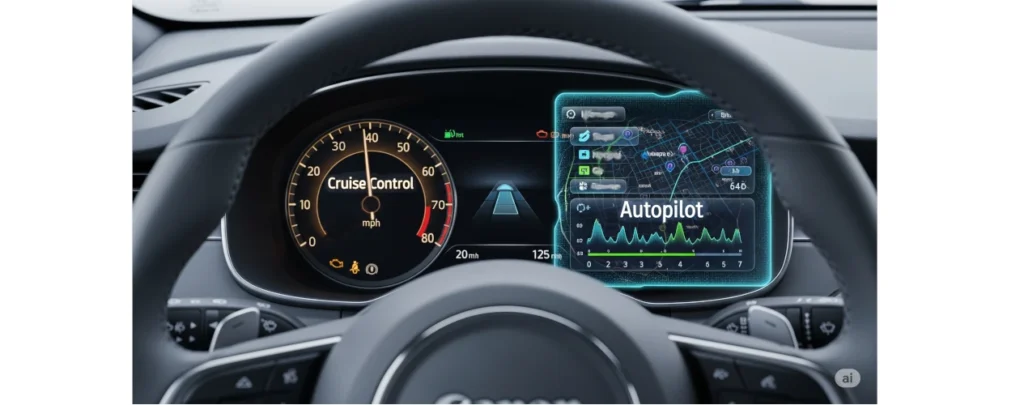
You’ve invested in software and tools to make things run more smoothly. Yet, you’re still buried in operational tasks, acting as the human glue between different systems. You’re working in the business, not on it.
Many business owners believe their automation is an “autopilot” system. In reality, it’s just “cruise control”—it maintains speed, but you still have to steer, watch for hazards, and handle any unexpected turns. Understanding this distinction is the key to truly transforming your operations.
Think of most business automation like a self-checkout kiosk at the grocery store. It’s certainly faster than the old way, but it’s rigid. It follows a simple, fixed script and is very good at that one process.
But what happens when something unexpected occurs? The light flashes, and an employee has to come over to solve the problem.
That’s the ceiling of simple automation. Even a good, streamlined process, when automated simply, remains just that—a single process. The limitation isn’t that the process is flawed; it’s that the automation is simple. It makes a task faster, but not necessarily smarter, and it can’t connect that task to the next one in a different system. You are still the one orchestrating the larger workflow.
The next step for many businesses is adding Artificial Intelligence (AI) for analytics and business intelligence. This gives your operation a powerful “brain.” It can analyze data to provide critical, data-driven insights—spotting trends, forecasting sales, or flagging potential issues in a dashboard.
The frustration? These are just alerts.
You and your team are still responsible for taking those insights and manually acting on them. The “brain” has spotted an opportunity, but it can’t execute the solution. This adds to your mental load instead of reducing it—a common challenge in digital transformation initiatives that Harvard Business Review notes can lead to employee burnout. You have more information, but not more time.
True autopilot is having a “brain and a body.” This combination of insight and action is the core of Agentic AI—a concept industry analysts like Gartner define as AI that can take proactive, goal-oriented action. Don’t let the term be confusing—it’s nothing more than tying individual smart agents together to accomplish a more comprehensive business process.
It’s the difference between a self-checkout kiosk and a personal shopper. You don’t give a personal shopper a rigid script; you give them a goal—”Find me a new suit for a wedding, under $500, that matches my blue shoes.”
Agentic AI works the same way. You give it a business goal, and an autonomous AI agent uses your existing tools to achieve it.
One of the biggest challenges I hear from my clients is how to turn this kind of hype into reality. Consider a common scenario where you need to onboard a new client. Instead of treating it as a dozen manual steps, you give the system a single goal:
Would a seamless process like that help you be more efficient? Could it drive top-line revenue by getting new clients to value faster? This is end-to-end hyperautomation in action.
Handing over the controls can feel daunting. But Agentic AI is about delegation, not abdication. You empower the system to act by setting the rules of engagement and establishing clear safeguards for transparency and quality assurance.
Building trust in an autonomous system comes from having clear visibility into its work. A well-designed system includes intelligent human oversight at critical steps to verify accuracy and build confidence. For example:
This ‘human-in-the-loop’ approach is a cornerstone of a responsible AI strategy, aligning with frameworks published by major tech leaders. It’s fundamental to building trust in your systems and ensuring your technology serves your strategic goals, rather than creating more operational busywork.
This isn’t a far-off concept; it’s what modern businesses are building today when they blend AI, automation, and analytics into a unified solution.
Moving from simple automation to an autonomous system is more than a technical upgrade; it’s a strategic shift. It’s about creating an operational environment that is resilient, intelligent, and frees up your most valuable resource—your team’s time and creativity—to focus on growth, innovation, and the customers you serve. It means graduating from simply overseeing tasks to truly commanding your business’s potential.
At Proactive Technology Management, our Fusion Development methodology is designed to deliver this capability, often with a proof of value in under 90 days. We provide the expertise to build your autopilot system, and you retain full ownership of all the IP and data—no black-box vendor lock-in.
Let’s find out where your biggest opportunities are for smart, autonomous automation.
👉 Book your free, no-risk consultation with the PTM Fusion Development Team today to get started.
Identify bottlenecks, automate workflows, and build fast.
Get Started Today